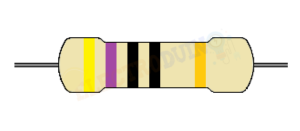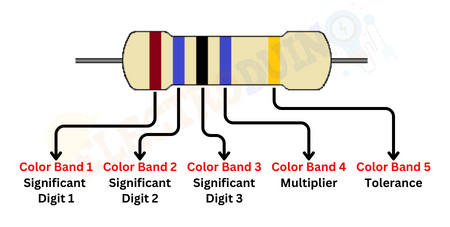5 Band Resistor Color Code Calculation Step by Step Guide
Hello friends! Welcome back to ElectroDuino. In the last tutorial, we discussed “What is Resistor: Definition, Types, Symbol, Color Code, Circuit, Application“, “Types of Resistors and they are Construction, Symbol, and Applications“, and “Resistor Color Code Trick | 4 Band Resistor Color Code“. This basic electronics blog tutorial is based on the 5 Band Resistor Color Code Calculation A Step by Step Guide. In this article, we will discuss What is a 5 Band Resistor Color Code, Color Code Chart, How to Read and Calculate Resistor Color Code, Examples.
Introduction
The resistor color code is a universal language used by engineers and hobbyists to determine a resistor’s resistance value and tolerance. As electronic systems demand higher precision, the 5-band resistor color code steps in to provide additional information. The 5-band resistor color code system builds upon the 4-band system. The 5-band resistor color code adds an extra layer of precision, introducing a third significant digit (3rd Color band) that imparts more precision to the resistance value.
5-Band Resistor Color code
A 5-band resistor typically consists of five individual colored bands placed around its cylindrical body. Each band has a unique role, providing specific information about the resistance value, and tolerance. The 5-band resistor color code follows a similar principle to the 4-band color code but introduces an additional band, adding a layer of complexity and precision.

A 5 band resistor has four color bands on the left side and one color band on the right side. The four color bands on the left side are very close to each other and the fifth (5th) color band on the right side is separated from the first four bands with some space.
Understanding the 5 Band Resistor Color code
To decode these bands, you need to understand their roles. Let’s break down the significance of each band.

First Band – Significant Digit (Digit 1):
Similar to the 4-band code system, this is the initial band, located closest to the left end of the resistor. The first band represents the first significant digit of the resistance value. The color of this band corresponds to a specific digit according to the standard color chart. Each color is assigned a unique numerical value, following the sequence: black (0), brown (1), red (2), orange (3), yellow (4), green (5), blue (6), violet (7), gray (8), and white (9).
Second Band – Significant Digit (Digit 2):
Similar to the first band, the second band represents the second significant digit of the resistance value. As with the first bands, Each color is assigned a unique numerical value.
Third Band – Significant Digit (Digit 3):
In a 5-band resistor, the third band provides an additional significant digit to the resistance value, providing greater precision. This extra significant digit enables the representation of resistors with values greater than 999 ohms. As with the first two bands, Each color is assigned a unique numerical value.
Fourth Band – Multiplier (Multiplier):
The fourth band denotes the multiplier by which the significant digits are multiplied. The multiplier is a power of 10 that scales the significant digits to obtain the final resistance value.
Fifth Band – Tolerance (Tolerance):
The fifth band indicates the tolerance of the resistor. The tolerance represents the permissible range of deviation from the specified resistance value. Common tolerance values include ±1%, ±2%, ±5%, and ±10%.
Calculating the Resistance Value A Step-by-Step Guide
let’s use an example we practically understand the step-by-step process of how to calculate the resistance value of a 5-band resistor:

Step 1: Identify the Significant Digits:
Identify the resistor’s color bands and note down the colors from left to right. The first three bands on the resistor represent significant digit 1, significant digit 2, and significant digit 3. The color of each band corresponds to a numerical value based on a standard color chart. Assign these values to digits 1, 2, and 3, signifying the first, second, and third significant digits, respectively.
Example:
The resistor color bands are arranged like Color Band 1: Brown, Color Band 2: Blue, and Color Band 3: Black.
Step 2: Determine the Multiplier:
Identify the value of the fourth band to find the multiplier. This value, often representing a power of 10, magnifies the impact of the significant digits on the overall resistance value.
Multiplier = 10 Fourth Band Numerical Values
Example:
The Multiplier is Color Band 4: Blue,
So, Multiplier = 10 6 [∵Blue = 6]
Step 3: Assign Numerical Values
Refer to the color code chart to assign numerical values to each color:
- First Band (Color 1): Significant Digit 1
- Second Band (Color 2): Significant Digit 2
- Third Band (Color 3): Significant Digit 3
- Fourth Band (Color 4): Multiplier
Example:
- First Band (Color A):1
- Second Band (Color B): 6
- Third Band (Color C): 0
- Fourth Band (Color D): 6
Step 3: Calculate the Resistance Value:
Combine the numerical values assigned to Color A, Color B, and Color C to get the significant digits. Multiply this value by the multiplier (Color D). This gives the resistance value in ohms. The 5 Band Resistor Color Code Formula to calculate resistance value is as follows:
Resistance (ohms) = (Digit 1 × 100 + Digit 2 × 10 + Digit 3) × Multiplier
This formula seamlessly integrates the contributions of each significant digit with the multiplier to yield the precise resistance value.
Example:
Resistance (ohms) = (1 × 100 + 6 × 10 + 0) × 106
= (100+60+0) × 106
= 160000000 ohm
= 160000 Kilo ohm [∵ 1000 ohm = 1 Kilo ohms ]
= 160 MΩ [∵ 1000000 ohm = 1 Mega ohms ]
Step 4: Check the Tolerance or Temperature Coefficient:
Identify the tolerance value from the fifth band. This value represents the permissible range of deviation from the calculated resistance value.
Example:
The Tolerance is Color Band 5: Gold
So, Tolerance = ±5%
Step 5: Final Result
Combine the results from steps 3 and 4 to obtain the final resistance value.
Example
Above mentioned resistor’s resistance value is 160 M ohms (MΩ) and the tolerance is ±5%.
So, we can write the Resistor’s resistance value as 160MΩ ±5%
5-Band Resistor Color Code Example
Example 1: Calculate the resistance value of the given resistor with the color bands (Code) sequence Red, Red, Black, Silver, and Gold.
- Red (Digit 1): 2
- Red (Digit 2): 2
- Black (Digit 3): 0
- Silver (Multiplier): 10-2
- Gold (Tolerance): ±5%
Calculate Resistance Value
Using the color code formula, the resistance value is calculated as:
Resistance (ohms) = (Digit 1 x 100 + Digit 2 x 10 + Digit 2) * Multiplier
Resistance = (2 ×100 + 2×10 + 0) × 10-2
= 2.2 Ω
Therefore, the resistor color coded with Red-Red-Black-Silver-Gold would have a resistance of 2.2 ohms with a tolerance of ± 5%. Also, we can write the resistance value of the given resistor as 2.2Ω ±5%.
Example 2: Calculate the resistance value of the given resistor with the color bands (Code) sequence Yellow, Violet, Black, Gold, and Gold.
- Yellow (Digit 1): 4
- Violet (Digit 2): 7
- Black (Digit 3): 0
- Gold (Multiplier): 10-1
- Gold (Tolerance): ±5%
Calculate Resistance Value
Using the color code formula, the resistance value is calculated as:
Resistance (ohms) = (Digit 1 x 100 + Digit 2 x 10 + Digit 2) * Multiplier
Resistance = (4 ×100 + 7×10 + 0) × 10-1
= 47 Ω
Therefore, the resistor color coded with Yellow-Violet-Black-Gold-Gold would have a resistance of 47 ohms with a tolerance of ± 5%. Also, we can write the resistance value of the given resistor as 47Ω ±5%.
Example 3: Calculate the resistance value of the given resistor with the color bands (Code) sequence Yellow, Violet, Black, Brown, and Gold.
- Yellow (Digit 1): 4
- Violet (Digit 2): 7
- Black (Digit 3): 0
- Brown (Multiplier): 101
- Gold (Tolerance): ±5%
Calculate Resistance Value
Using the color code formula, the resistance value is calculated as:
Resistance (ohms) = (Digit 1 x 100 + Digit 2 x 10 + Digit 2) * Multiplier
Resistance = (4 ×100 + 7×10 + 0) × 101
= 4700 ohm
= 4.7 Kilo ohm [∵ 1000 ohm = 1 Kilo ohms ]
Therefore, the resistor color coded with Yellow-Violet-Black-Brown-Gold would have a resistance of 4.7 Kilo ohms with a tolerance of ± 5%. Also, we can write the resistance value of the given resistor as 4.7KΩ ±5%.
Example 4: Calculate the resistance value of the given resistor with the color bands (Code) sequence Brown, Black, Black, Red, and Gold.
- Brown (Digit 1): 1
- Black (Digit 2): 0
- Black (Digit 3): 0
- Red (Multiplier): 102
- Gold (Tolerance): ±5%
Calculate Resistance Value
Using the color code formula, the resistance value is calculated as:
Resistance (ohms) = (Digit 1 x 100 + Digit 2 x 10 + Digit 2) * Multiplier
Resistance = (1 ×100 + 0×10 + 0) × 102
= 10000 ohms
= 10 Kilo ohms [∵ 1000 ohm = 1 Kilo ohms ]
Therefore, the resistor color coded with Brown-Black-Black-Red-Gold would have a resistance of 10 Kilo ohms with a tolerance of ± 5%. Also, we can write the resistance value of the given resistor as 10KΩ ±5%.
Example 5: Calculate the resistance value of the given resistor with the color bands (Code) sequence Brown, Green, Black, Orange, and Gold.
- Brown (Digit 1): 1
- Green (Digit 2): 5
- Black (Digit 3): 0
- Orange (Multiplier): 103
- Gold (Tolerance): ±5%
Calculate Resistance Value
Using the color code formula, the resistance value is calculated as:
Resistance (ohms) = (Digit 1 x 100 + Digit 2 x 10 + Digit 2) * Multiplier
Resistance = (1 ×100 + 5×10 + 0) × 102
= 150000 ohms
= 150 Kilo ohms [∵ 1000 ohm = 1 Kilo ohms ]
Therefore, the resistor color coded with Brown-Green-Black-Orange-Gold would have a resistance of 150 Kilo ohms with a tolerance of ± 5%. Also, we can write the resistance value of the given resistor as 150KΩ ±5%.
Example 6: Calculate the resistance value of the given resistor with the color bands (Code) sequence Red, Green, Black, Yellow, and Gold.
- Red (Digit 1): 2
- Green (Digit 2): 5
- Black (Digit 3): 0
- Yellow (Multiplier): 104
- Gold (Tolerance): ±5%
Calculate Resistance Value
Using the color code formula, the resistance value is calculated as:
Resistance (ohms) = (Digit 1 x 100 + Digit 2 x 10 + Digit 2) * Multiplier
Resistance = (2 ×100 + 5×10 + 0) × 104
= 25000000 ohms
= 2500 Kilo ohms [∵ 1000 ohm = 1 Kilo ohms ]
= 2.5 Mega ohms [∵ 1000000 ohm = 1 Mega ohms ]
Therefore, the resistor color coded with Red-Green-Black-Yellow-Gold would have a resistance of 2.5 Mega ohms with a tolerance of ± 5%. Also, we can write the resistance value of the given resistor as 2.5MΩ ±5%.
How do you read a 5 band resistor color code?
5 band resistor color code chart

